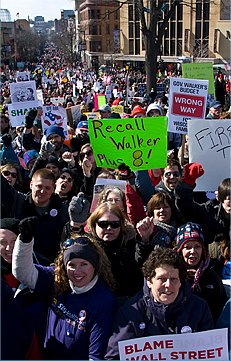Wisconsin: What We're Learning

From Wisconsinites and visitors alike, the sentiment is the same: “I’ve never seen anything like it.”
The revolt in Wisconsin is the most impressive response of American workers to the employer offensive since it began 31 years ago—remarkable for its numbers, for its sustained nature, for the labor-community-student coalition that spontaneously arose.
The stunning support from non-union workers distinguishes it from most other labor struggles. In insisting on the right of workers to have something to say about their conditions of employment, it expresses the bedrock basis of unionism.
The May Day 2006 walkout and demonstrations for immigrant rights were larger in numbers, but the Wisconsin actions have been more sustained.
The Wisconsin revolt is filled with lessons for unionists under the gun across the country.
WHAT THEY DID
First and foremost was the power of a strike. The teachers’ illegal two-day statewide strike set the stage for everything that was to follow.
The strike not only swelled crowds in the Capitol but showed straight away the depth of opposition to Governor Scott Walker’s attack on union rights. Hundreds of Madison high school students walked out. Massive demonstrations repeatedly crowded the capital, with turnout over 100,000 on the two biggest Saturdays.
Those demonstrations and hundreds of other actions gave 14 Democratic legislators the spine to leave the state and stay away for three weeks.
Impressive numbers of private sector union members joined in, as well as firefighters and police not affected by Walker’s bill. Their turnout is the definition of solidarity.

The occupation of the Capitol, organized by the teaching assistants union, created a freed space. “I was awestruck at the mighty roars of democracy,” said visitors such as Miya Williamson, a public employee from Michigan. “I will never be the same.”
It wasn’t just Madison. Demonstrations bloomed all over the state. In Gays Mills, a one-street town of no more than 100, citizens packed a diner to confront their state senator.
In Black River Falls, population 3,366, unionists took it on themselves to hold banners on a bridge, asking for honks, as many as 150 people at a time. Senior citizens organized as Gray Panthers and put on flash mobs, 50 people the first day, 150 four days later.
In the first days, demonstrators showed they were taking cues from the freedom movements rocking North Africa, with signs likening Walker to Mubarak. Egyptians reciprocated, sending money for pizza.
Tens of thousands in the U.S. rallied behind Wisconsin in their home capitals. In faraway Richmond, California, for example, the city council took a stand for its own public employees and resolved to support the collective bargaining rights of workers in Wisconsin. Delegations flocked to Madison to share the spirit. Meanwhile, workers demonstrated repeatedly by the thousands inside and outside statehouses in Indiana and Ohio.

SUPPORT LABOR NOTES
BECOME A MONTHLY DONOR
Give $10 a month or more and get our "Fight the Boss, Build the Union" T-shirt.
The public responded sympathetically. A Bloomberg poll found 64 percent nationally saying public employees should have the right to bargain collectively, and 72 percent with a favorable opinion of public employees.
It seemed that after decades of wage cuts, layoffs, service cuts, and two-tier for union and non-union alike, most were glad to see someone fighting back.
TOTAL RECALL
Wisconsin workers are bursting with pride at their dedication, energy, persistence, commitment to principle, and commitment to peaceful protest.
Remarkably, union leaders at higher levels did not attempt to tamp down the struggle in its first weeks. Even the most hidebound seemed to realize that it was workers’ boldly standing up for themselves that had made unions popular again.
Faced with the decimation of union power, they could see that the universal mobilization was working to keep the heat on both Republicans and Democrats. When the AFL-CIO began the recall of eight Republican senators, leaders did not try to shift all action there—which no doubt would have proved difficult.
The mobilization to garner signatures for the recall became a major focus because rank and filers made it one.
Karl Gartung, a Milwaukee steward in Teamsters Local 344, said people are self-recruiting to the campaign in big numbers, an outpouring of spirit he called “pure joyful anger.” Republicans, meanwhile, are using the billionaire Koch brothers’ money to pay for their canvassers, according to Democratic officials.
By March 14 petitioners in three of the senate districts had more than half the signatures required, with the deadline not till May 1.
The recall was soon followed by the beginnings of corporate campaigns against the banks and corporations that bankroll the right wing in Wisconsin. Firefighters led the campaign to “Move Your Money” out of M&I Bank, a major Walker contributor (which even let him use its private tunnel to escape the crowds at the Capitol).
NUCLEAR OPTION
After the state senate took the nuclear option March 9 and passed a version of the “budget repair” bill, though, no one on the union side seemed ready to respond in kind. Mary Bell, president of the state teachers union WEAC, who had called members out three weeks before, told them to go to work.
A union movement unused to defiance had taken remarkable steps, but now it chose caution, unsure of consequences and unwilling to risk loss of public support. No one had prepared for this moment.
Would Walker, who fancies himself the heir to Ronald Reagan, fire strikers? Would public opinion turn the other way? Jim Cavanaugh, president of Madison’s South Central Federation of Labor, said, “To do it right, there’s a lot of preparation. You’re exposing people to job loss and other repercussions if appropriate steps aren’t taken.”
Like what? See the potential arrows in labor’s quiver.





